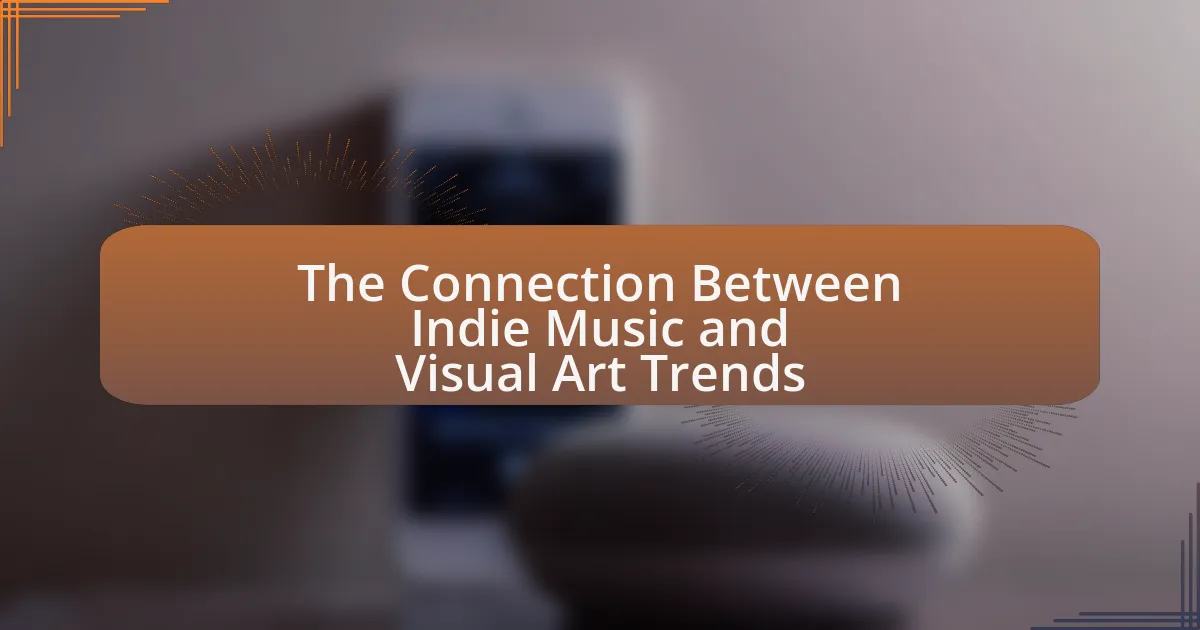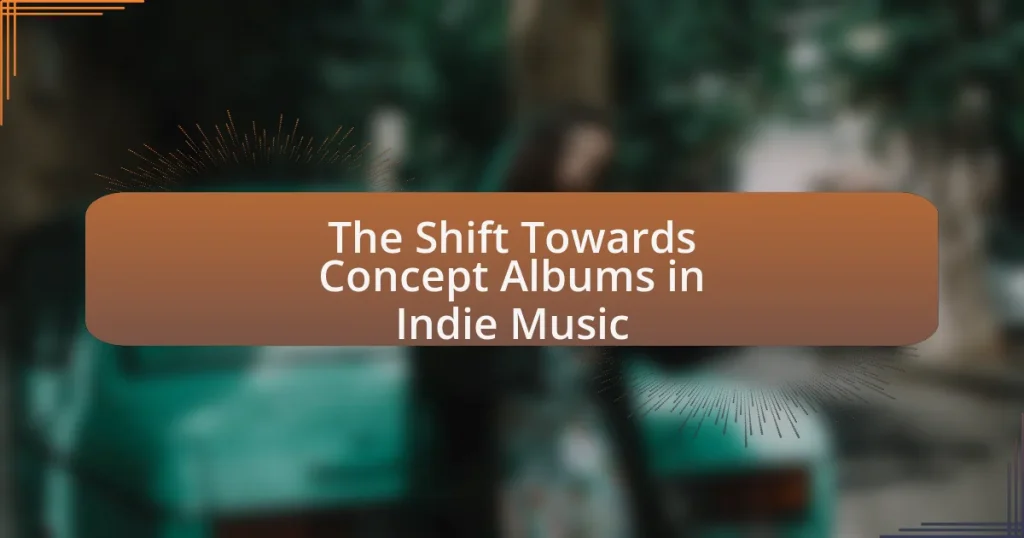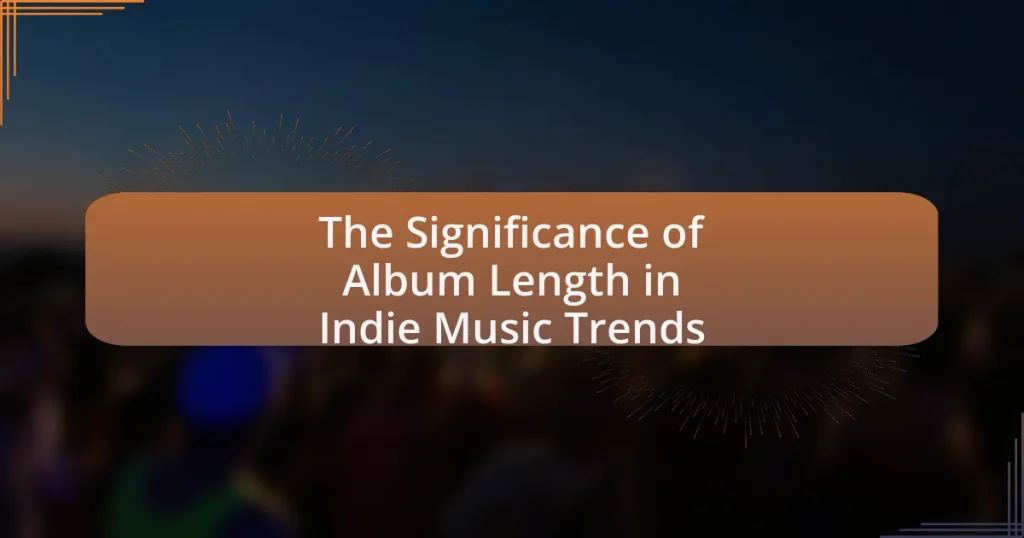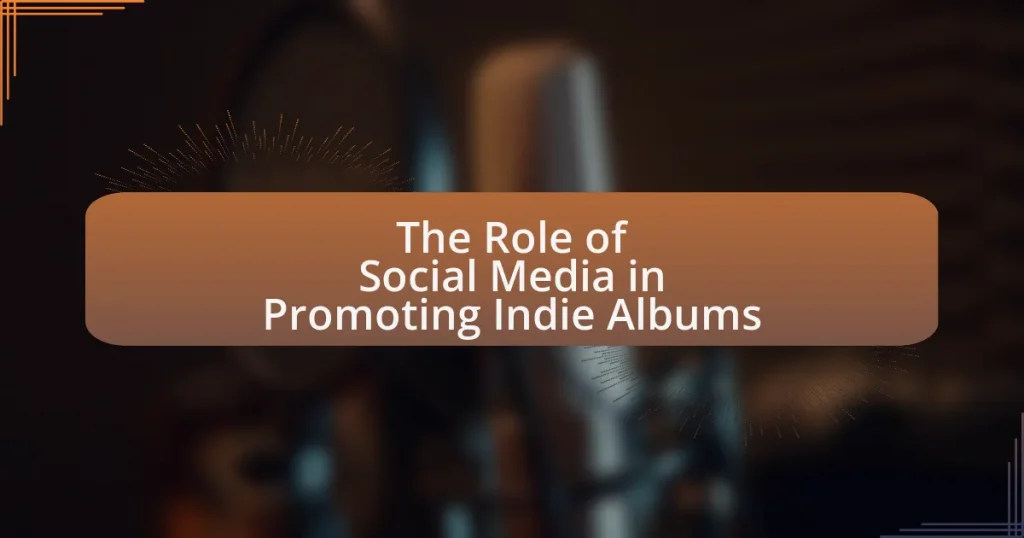The article explores the intricate connection between indie music and visual art trends, highlighting their shared emphasis on creativity, individuality, and cultural commentary. It examines how these two fields influence each other through collaborative projects, historical ties, and the impact of contemporary trends, including the role of social media and digital platforms. Key themes such as social commentary, personal experiences, and the DIY ethos are discussed, along with practical tips for artists seeking to bridge the gap between music and visual art. The article underscores the significance of this relationship in fostering innovative expressions and enriching cultural dialogue.
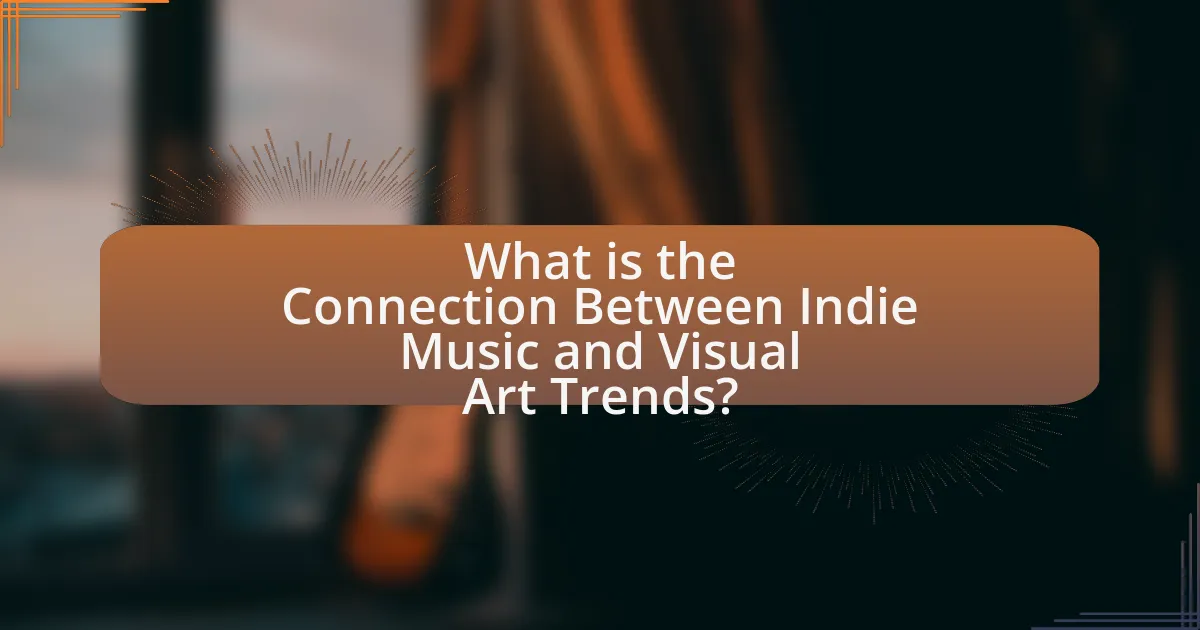
What is the Connection Between Indie Music and Visual Art Trends?
Indie music and visual art trends are interconnected through their shared emphasis on creativity, individuality, and cultural commentary. Indie music often reflects and influences visual art by promoting alternative aesthetics and themes that challenge mainstream norms. For instance, album covers and music videos frequently showcase innovative artistic styles, drawing from contemporary art movements such as surrealism and minimalism. This synergy is evident in the works of artists like David Bowie, whose album art and music videos have inspired visual artists, and in the collaboration between musicians and visual artists at events like art fairs and music festivals. The mutual influence is further supported by the rise of social media platforms, which allow indie musicians and visual artists to share their work and reach wider audiences, fostering a vibrant cultural exchange.
How do indie music and visual art influence each other?
Indie music and visual art influence each other through collaborative projects and shared aesthetic values. Musicians often draw inspiration from visual art to create album covers, music videos, and stage designs, which enhance the overall artistic expression of their work. For instance, the album cover for “Yankee Hotel Foxtrot” by Wilco features artwork that reflects the themes of the music, creating a cohesive artistic experience. Conversely, visual artists frequently incorporate elements of indie music into their work, using sound as a backdrop for installations or performances, as seen in the works of artists like Pipilotti Rist, who integrates music into her visual narratives. This reciprocal relationship fosters a vibrant cultural dialogue, enriching both fields and allowing for innovative expressions that resonate with audiences.
What are the historical ties between indie music and visual art?
Indie music and visual art have historically been intertwined through shared cultural movements and collaborative projects. The emergence of indie music in the 1980s coincided with the rise of alternative art movements, such as punk and post-punk, where visual artists often created album covers and promotional materials for indie bands, exemplified by artists like Jamie Reid, who designed for the Sex Pistols. Additionally, the DIY ethos prevalent in indie music encouraged artists to explore multimedia expressions, leading to collaborations in live performances and art installations, as seen in the works of bands like Sonic Youth, who integrated visual art into their concerts. This synergy has continued into the 21st century, with indie musicians frequently collaborating with visual artists to create immersive experiences that blend sound and sight, reinforcing the historical ties between these two creative fields.
How do artists in both fields collaborate?
Artists in both indie music and visual art collaborate through joint projects, exhibitions, and performances that blend their mediums. For instance, musicians often work with visual artists to create album covers, music videos, and live show visuals, enhancing the overall aesthetic experience of their work. A notable example is the collaboration between the band Radiohead and visual artist Stanley Donwood, who has designed their album artwork since the 1990s, creating a cohesive visual identity that complements the band’s music. This synergy not only enriches the artistic expression but also broadens the audience reach for both artists, as seen in events like art installations that feature live music performances, fostering a cross-disciplinary dialogue.
Why is the connection between indie music and visual art significant?
The connection between indie music and visual art is significant because it fosters a unique cultural synergy that enhances both forms of expression. This relationship allows artists to collaborate, creating immersive experiences that engage audiences on multiple sensory levels. For instance, album artwork often reflects the themes and emotions of the music, while music videos serve as a visual narrative that complements the auditory experience. Historical examples include the collaboration between musicians like David Bowie and visual artists such as Andy Warhol, which not only shaped their respective careers but also influenced broader artistic movements. This interplay enriches the indie music scene, making it a vibrant platform for innovation and creativity.
What cultural movements have shaped this connection?
The connection between indie music and visual art trends has been shaped primarily by the DIY (Do It Yourself) movement, the counterculture of the 1960s, and the rise of postmodernism in the late 20th century. The DIY movement encouraged artists and musicians to create and distribute their work independently, fostering a collaborative spirit that blurred the lines between music and visual art. The counterculture of the 1960s, characterized by a rejection of mainstream values, promoted artistic experimentation and social commentary, influencing both indie music and visual art. Additionally, postmodernism’s embrace of eclecticism and pastiche allowed for cross-pollination between various artistic disciplines, further solidifying the relationship between indie music and visual art trends.
How does this connection reflect societal changes?
The connection between indie music and visual art trends reflects societal changes by showcasing the evolving values of creativity, individuality, and community engagement. This relationship highlights a shift towards a more inclusive and diverse cultural landscape, where artists from various backgrounds collaborate and express their unique perspectives. For instance, the rise of social media platforms has enabled indie musicians and visual artists to reach wider audiences, fostering a sense of community and shared identity among fans. Additionally, the themes explored in indie music often address contemporary social issues, such as mental health and social justice, mirroring the growing public discourse around these topics. This synergy between music and art not only illustrates the changing tastes and preferences of society but also emphasizes the importance of artistic expression as a means of social commentary and connection.
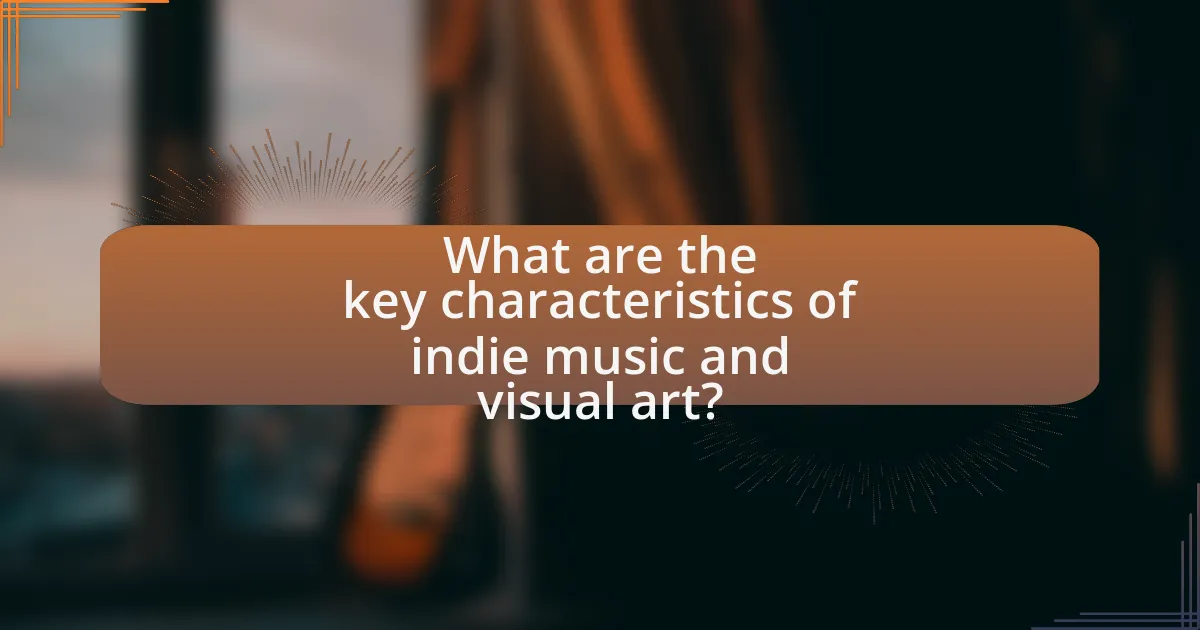
What are the key characteristics of indie music and visual art?
Indie music and visual art are characterized by their emphasis on individuality, creativity, and a DIY (do-it-yourself) ethos. Indie music often features unconventional song structures, diverse genres, and a focus on personal expression, while indie visual art showcases unique styles, experimental techniques, and a rejection of mainstream commercialism.
The indie music scene is known for its grassroots approach, with artists often self-releasing their work and utilizing platforms like Bandcamp and SoundCloud to reach audiences directly. This independence allows for a wide range of sounds and themes, often reflecting personal or social issues. Similarly, indie visual artists frequently operate outside traditional gallery systems, using social media and alternative spaces to display their work, which fosters a sense of community and collaboration.
Both indie music and visual art prioritize authenticity and originality, often drawing inspiration from subcultures and countercultural movements. This connection is evident in the cross-pollination of ideas, where musicians collaborate with visual artists for album covers, music videos, and live performances, creating a cohesive aesthetic that resonates with audiences seeking authenticity.
How do the aesthetics of indie music manifest in visual art?
The aesthetics of indie music manifest in visual art through a focus on authenticity, DIY culture, and eclectic styles. Indie music often embraces a raw, unpolished sound that translates into visual art characterized by handmade elements, vibrant colors, and unconventional materials. For example, album covers from indie bands frequently feature unique illustrations or photography that reflect personal narratives and emotional depth, aligning with the music’s themes. This connection is evident in the works of artists like David Carson, who designed iconic album covers for indie bands in the 1990s, emphasizing a non-traditional approach that resonates with the indie ethos. Additionally, art movements associated with indie music, such as lo-fi aesthetics and collage techniques, further illustrate this relationship by prioritizing individual expression over commercial polish.
What visual elements are commonly found in indie music album covers?
Indie music album covers commonly feature hand-drawn illustrations, bold typography, and a mix of vibrant and muted color palettes. These visual elements reflect the DIY ethos of indie music, emphasizing creativity and individuality. For instance, many covers utilize collage techniques or abstract art, which resonate with the genre’s experimental nature. Additionally, the use of vintage aesthetics and nostalgic imagery is prevalent, often evoking a sense of authenticity and personal connection. This trend aligns with the broader cultural movement within indie music that values artistic expression over commercial appeal.
How do music videos serve as a form of visual art?
Music videos serve as a form of visual art by combining music with visual storytelling, utilizing elements such as cinematography, choreography, and artistic direction to create a cohesive aesthetic experience. This integration allows artists to express themes and emotions visually, enhancing the narrative of the song. For instance, the music video for “This Is America” by Childish Gambino employs striking imagery and symbolism to comment on social issues, demonstrating how visual art can amplify the message of the music. Additionally, the use of innovative techniques, such as animation or surreal visuals, further establishes music videos as a distinct art form, capable of evoking emotional responses and provoking thought, similar to traditional visual art mediums.
What themes are prevalent in both indie music and visual art?
Themes prevalent in both indie music and visual art include introspection, individuality, and social commentary. Introspection is often expressed through personal narratives in indie music lyrics and reflective visual art pieces, allowing artists to explore their inner thoughts and emotions. Individuality is celebrated in both mediums, with artists embracing unique styles and perspectives that challenge mainstream norms. Social commentary is also a significant theme, as both indie musicians and visual artists address societal issues, such as inequality and environmental concerns, through their work, fostering dialogue and awareness among audiences.
How do personal experiences shape the themes in indie music and visual art?
Personal experiences significantly shape the themes in indie music and visual art by providing authentic narratives and emotional depth. Artists often draw from their own life events, relationships, and struggles, which leads to a more relatable and genuine expression of feelings. For instance, studies show that musicians like Sufjan Stevens and visual artists such as Frida Kahlo have incorporated personal trauma and identity exploration into their work, resulting in themes of loss, love, and self-discovery. This connection between personal experience and artistic expression fosters a unique resonance with audiences, as listeners and viewers can find reflections of their own lives in the art.
What role does social commentary play in both mediums?
Social commentary serves as a critical lens through which both indie music and visual art express societal issues and cultural critiques. In indie music, artists often address themes such as inequality, identity, and political unrest, using lyrics to provoke thought and inspire change. For instance, songs like “This Is America” by Childish Gambino highlight systemic racism and gun violence, resonating with listeners and sparking discussions. Similarly, visual art, through mediums like painting and installation, reflects social realities and challenges norms, as seen in works by artists like Banksy, who critiques consumerism and political corruption. Both mediums utilize their platforms to engage audiences, fostering awareness and dialogue about pressing social issues.
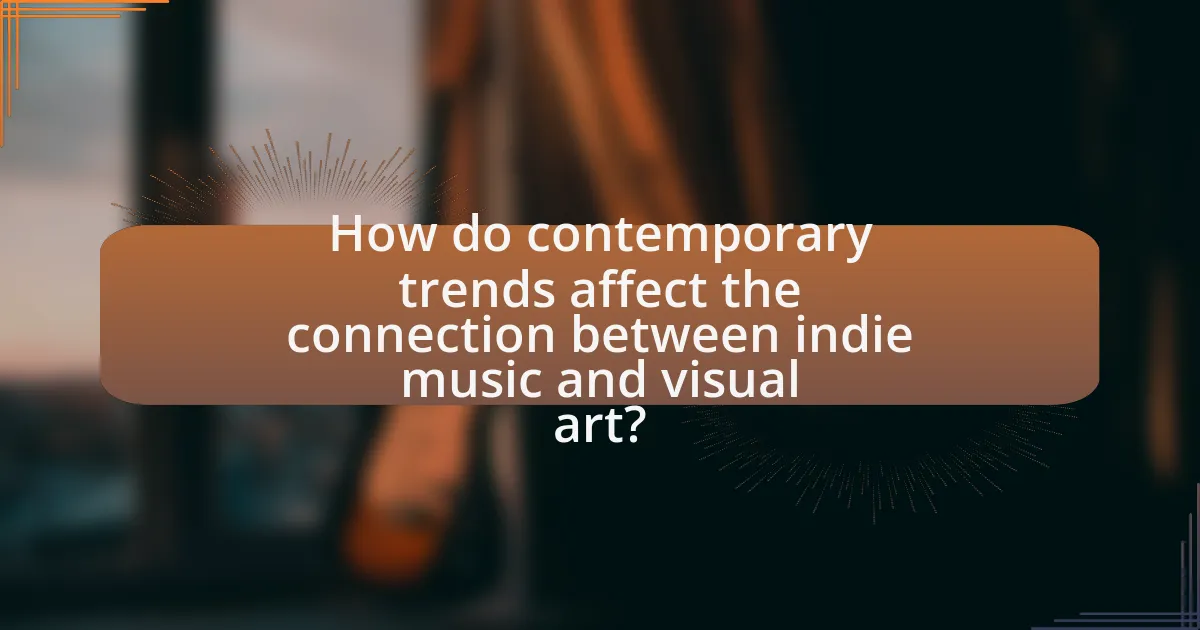
How do contemporary trends affect the connection between indie music and visual art?
Contemporary trends significantly enhance the connection between indie music and visual art by fostering collaborative projects and cross-disciplinary expressions. The rise of digital platforms allows indie musicians and visual artists to share their work more easily, leading to innovative collaborations such as album art that doubles as visual storytelling. For instance, the integration of augmented reality in album releases, as seen with artists like Björk, merges music with immersive visual experiences, creating a multi-sensory engagement. Additionally, social media trends promote visual aesthetics in music promotion, compelling artists to create visually striking content that resonates with audiences, thereby strengthening the bond between the two art forms.
What current trends are emerging in the indie music scene?
Current trends in the indie music scene include the rise of genre-blending, increased use of digital platforms for distribution, and a focus on social and political themes in lyrics. Genre-blending allows artists to experiment with various styles, leading to innovative sounds that attract diverse audiences. Digital platforms like Bandcamp and Spotify have become essential for indie musicians, enabling them to reach global listeners without traditional label support. Additionally, many indie artists are addressing social issues such as climate change and mental health in their music, reflecting a growing trend towards activism within the genre. This trend is supported by data showing that songs with socially conscious themes have gained popularity on streaming platforms, indicating a shift in listener preferences.
How are digital platforms influencing visual art in music?
Digital platforms are significantly influencing visual art in music by providing artists with accessible tools for creation, distribution, and promotion. These platforms, such as Instagram, TikTok, and Spotify, enable musicians to showcase their visual aesthetics alongside their music, fostering a deeper connection with audiences. For instance, artists like Billie Eilish and Lil Nas X utilize visually striking imagery and videos on social media to enhance their musical narratives, leading to increased engagement and fan interaction. Additionally, the rise of digital art forms, such as animated album covers and interactive music videos, has transformed traditional visual art in music, allowing for innovative expressions that resonate with contemporary audiences. This shift is evidenced by the growing trend of collaborations between musicians and visual artists, as seen in projects like the “Art on a Music Album” initiative, which merges visual creativity with sound, further solidifying the impact of digital platforms on the visual art landscape in music.
What role does social media play in promoting indie artists and visual art?
Social media serves as a crucial platform for promoting indie artists and visual art by providing direct access to audiences and enabling widespread sharing of creative work. It allows indie artists to showcase their art, connect with fans, and build a community without the need for traditional gatekeepers like galleries or record labels. For instance, platforms like Instagram and TikTok have become essential for artists to display their portfolios and engage with followers, leading to increased visibility and opportunities for collaboration. According to a 2021 survey by the National Endowment for the Arts, 72% of artists reported using social media to promote their work, highlighting its significance in the contemporary art landscape.
How are indie music festivals integrating visual art?
Indie music festivals are integrating visual art by incorporating immersive installations, live painting, and multimedia performances that enhance the overall experience. For instance, festivals like Coachella and Bonnaroo have featured large-scale art installations and interactive exhibits that engage attendees, creating a fusion of auditory and visual experiences. This integration not only attracts a diverse audience but also supports local artists, as many festivals collaborate with regional creatives to showcase their work. The trend reflects a growing recognition of the importance of visual art in enriching the cultural landscape of music festivals, as evidenced by the increasing number of art-focused events and workshops within these festivals.
What types of visual art are showcased at indie music festivals?
Indie music festivals showcase a variety of visual art forms, including installations, paintings, photography, and digital art. These art types enhance the festival experience by creating immersive environments that reflect the festival’s themes and the artists’ visions. For instance, large-scale murals and interactive installations are often featured, allowing attendees to engage with the art physically and emotionally. Additionally, photography exhibitions capturing the essence of indie music culture are common, providing a visual narrative that complements the performances. This integration of visual art not only enriches the atmosphere but also fosters a deeper connection between the audience and the music, highlighting the symbiotic relationship between indie music and visual art trends.
How do these festivals enhance the overall experience for attendees?
Festivals enhance the overall experience for attendees by providing immersive environments that combine music, art, and community engagement. These events create a unique atmosphere where attendees can enjoy live performances while interacting with visual art installations, fostering a deeper appreciation for both art forms. Research indicates that such multi-sensory experiences can lead to increased emotional engagement and satisfaction among participants, as evidenced by studies showing that attendees often report heightened feelings of joy and connection during these events.
What practical tips can artists use to bridge indie music and visual art?
Artists can bridge indie music and visual art by collaborating on multimedia projects that combine both forms of expression. For instance, musicians can work with visual artists to create album artwork that reflects the themes of their music, enhancing the overall artistic experience. Additionally, hosting joint exhibitions or performances allows artists to showcase their work in a shared space, fostering a dialogue between the two mediums. Research indicates that cross-disciplinary collaborations can lead to innovative outcomes, as seen in events like the Coachella Music and Arts Festival, where visual art installations complement musical performances, attracting diverse audiences and enhancing engagement.
How can musicians collaborate with visual artists effectively?
Musicians can collaborate with visual artists effectively by establishing clear communication and shared goals for their projects. This collaboration can take various forms, such as creating album artwork, music videos, or live performances that integrate visual elements. For instance, the partnership between musician Björk and visual artist Andrew Huang resulted in innovative music videos that enhanced the storytelling of her songs. Such collaborations often lead to unique artistic expressions that resonate with audiences, as evidenced by the success of projects like the “Art of Music” initiative, which showcases the synergy between sound and visual art.
What resources are available for artists looking to explore this connection?
Artists looking to explore the connection between indie music and visual art trends can utilize various resources, including online platforms, workshops, and collaborative projects. Websites like SoundCloud and Bandcamp provide access to indie music, while platforms such as Behance and DeviantArt showcase visual art, allowing artists to draw inspiration from both fields. Additionally, workshops and events hosted by organizations like the Creative Capital Foundation offer opportunities for artists to engage in interdisciplinary practices. Collaborative projects, such as those organized by local art collectives, further facilitate the merging of music and visual art, fostering a community where artists can share ideas and techniques.
